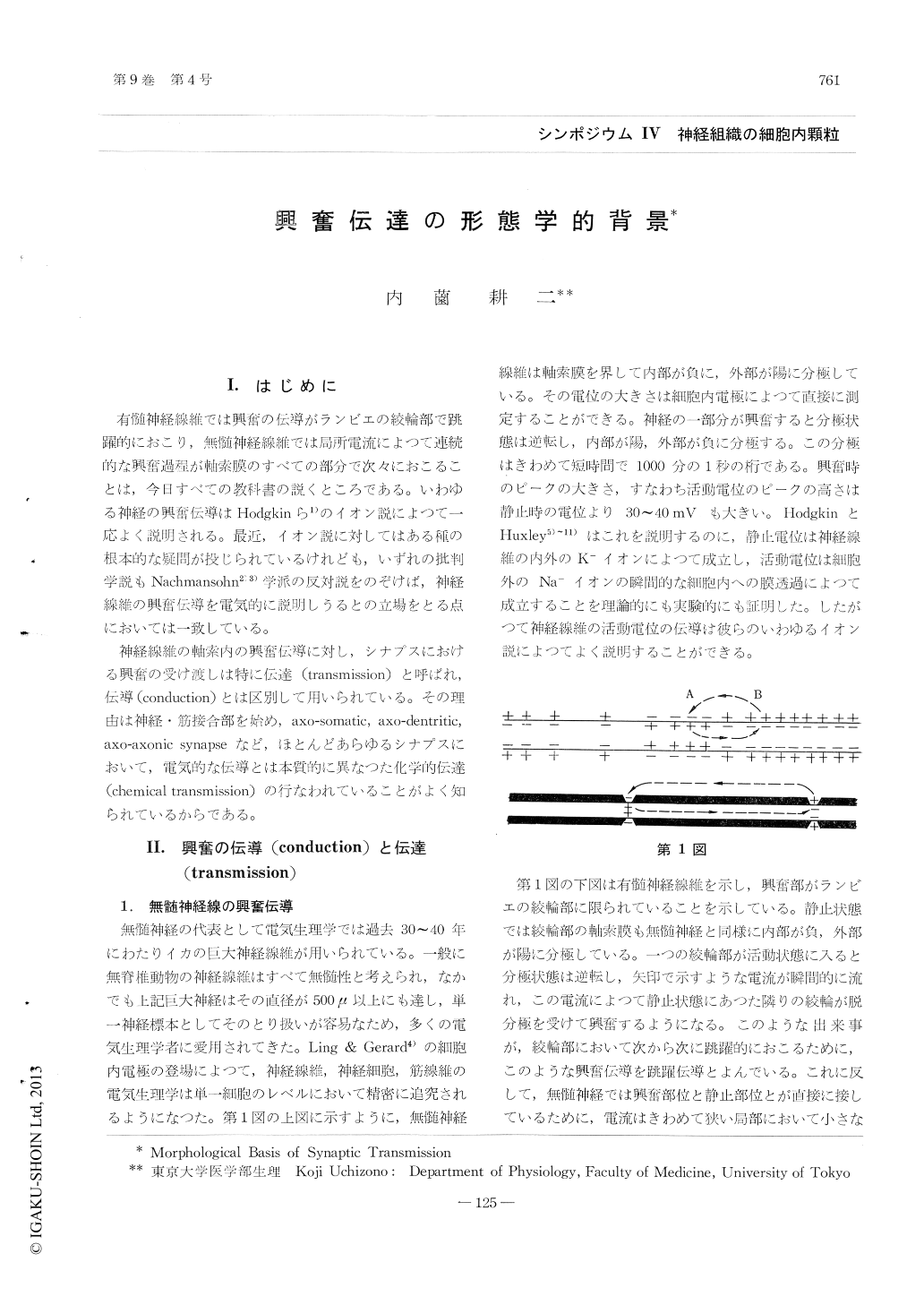Japanese
English
- 有料閲覧
- Abstract 文献概要
- 1ページ目 Look Inside
I.はじめに
有髄神経線維では興奮の伝導がランビエの絞輪部で跳躍的におこり,無髄神経線維では局所電流によつて連続的な興奮過程が軸索膜のすべての部分で次々におこることは,今日すべての教科書の説くところである。いわゆる神経の興奮伝導はHodgkinら1)のイオン説によつて一応よく説明される。最近,イオン説に対してはある種の根本的な疑問が投じられているけれども,いずれの批判学説もNachmansohn2)3)学派の反対説をのぞけば,神経線維の興奮伝導を電気的に説明しうるとの立場をとる点においては一致している。
神経線維の軸索内の興奮伝導に対し,シナプスにおける興奮の受け渡しは特に伝達(transmission)と呼ばれ,伝導(conduction)とは区別して用いられている。その理由は神経・筋接合部を始め,axo-sonlatic,axo-dentritic,axo-axonic synapseなど,ほとんどあらゆるシナプスにおいて,電気的な伝導とは本質的に異なつた化学的伝達(chemical transmission)の行なわれていることがよく知られているからである。
Chemical nature of synaptic transmission hasbeen established both electrophysiologically andpharmacologically. Bennett and De Robertis showedelectron microscopically a specific structure at thesynaptic sites of neuromuscular junctions. Thepresent author assumed that the number of thesynaptic vesicles would be changed if the strongelectrical stimuli were given to the preganglionicnerve trunk. In order to scrutinize this hypothesiselectrical stimuli were applied to the preganglionicnerve trunk of amphibian sympathetic ganglion. 25 per second stimuli of rectangular pulses wereused as the most effective stimulation of thesynapses. Microelecrodes were inserted into aneuron to control the time of fixation of theganglion. Membrane resting and action potentialsof a neuron were displayed on the screen of theoscilloscope. About ten minutes after the stimuluswas begun, marked changes in the membraneaction potentials, although slight changes of theresting membrane potentials were also recognized on the oscilloscope screen. The flexion on the rising phase of the action potentials was recognized quite often. Later on action potentials were separated from the EPSYs, the latter being maintained until later. But at the end of the stimulation almost no trace of EPSPs was displayed on the screen of the oscilloscope. At this moment OsO4 solution was poured on to the ganglion to fix it momemtarily. Electrical events disappeared instantaneously. After dehydration and embedding the ganglion was investigated by the electron microscope. Drastic changes were proved in the synapses of neurons. In some of the synapses the number of the synaptic vesicles was reduced to the minimum, leaving the recidual substance only in the empty space of the synapses. Drastic changes were also recognized in the cytoplasm of a neuron. Droplets in the cytoplasm of a neuron decreased in number and many vacuoles were left at the sites of the droplets, suggesting that the preganglionic nerve stimuli gave rise to a drastic change in the cytoplasm of a postganglionic neuron. It may be concluded that the synaptic vesicles of theamphibian sympathetic ganglion are essentially related to the synaptic transmission in neurons ofthe sympathetic ganglion of amphibia.

Copyright © 1965, Igaku-Shoin Ltd. All rights reserved.


